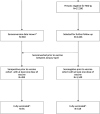This is a preprint.
Antibody Response to COVID-19 vaccination in Patients Receiving Dialysis
- PMID: 34013281
- PMCID: PMC8132255
- DOI: 10.1101/2021.05.06.21256768
Antibody Response to COVID-19 vaccination in Patients Receiving Dialysis
Update in
-
Antibody Response to COVID-19 Vaccination in Patients Receiving Dialysis.J Am Soc Nephrol. 2021 Oct;32(10):2435-2438. doi: 10.1681/ASN.2021050611. Epub 2021 Jun 11. J Am Soc Nephrol. 2021. PMID: 34117129 Free PMC article. No abstract available.
Abstract
Background: Patients receiving dialysis may mount impaired responses to COVID19 vaccination.
Methods: We report antibody response to vaccination from 1140 patients without, and 493 patients with pre-vaccination SARS-CoV-2 RBD antibody. We used commercially available assays (Siemens) to test remainder plasma monthly in association with vaccination date and type, and assess prevalence of absent total receptor binding antibody, and absent or attenuated (index value < 10) semiquantitative receptor binding domain IgG index values. We used Poisson regression to evaluate risk factors for absent or attenuated response to vaccination.
Results: Among patients who were seronegative versus seropositive before vaccination, 62% and 56% were ≥65 years old, 20% and 24% were Hispanic, and 22% and 23% were Black. Median IgG index values rose steadily over time, and were higher among the seropositive than in the seronegative patients after completing vaccination (150 [25th, 75th percentile 23.2, 150.0] versus 41.6 [11.3, 150.0]). Among 610 patients who completed vaccination (assessed ≥14 days later, median 29 days later), the prevalence of absent total RBD response, and absent and attenuated semiquantitative IgG response was 4.4% (95% CI 3.1, 6.4%), 3.4% (2.4, 5.2%), and 14.3% (11.7, 17.3%) respectively. Risk factors for absent or attenuated response included longer vintage of end-stage kidney disease, and lower pre-vaccination serum albumin.
Conclusions: More than one in five patients receiving dialysis had evidence of an attenuated immune response to COVID19 vaccination.
Keywords: COVID-19; SARS-CoV-2; immune response; vaccination; vulnerable populations.
Figures


References
-
- Center for Medicare and Medicaid Services. Preliminary Medicare Covid-19 Data Snapshot. https://wwwcmsgov/files/document/medicare-covid-19-data-snapshot-fact-sh.... 2020.
Publication types
Grants and funding
LinkOut - more resources
Full Text Sources
Other Literature Sources
Miscellaneous
